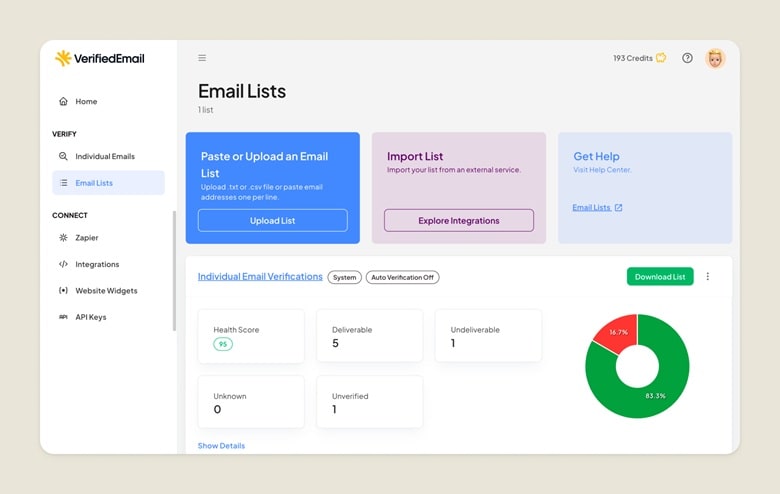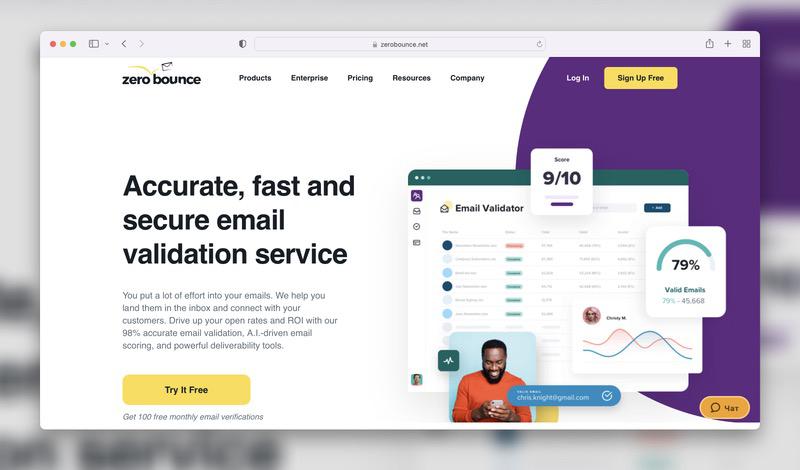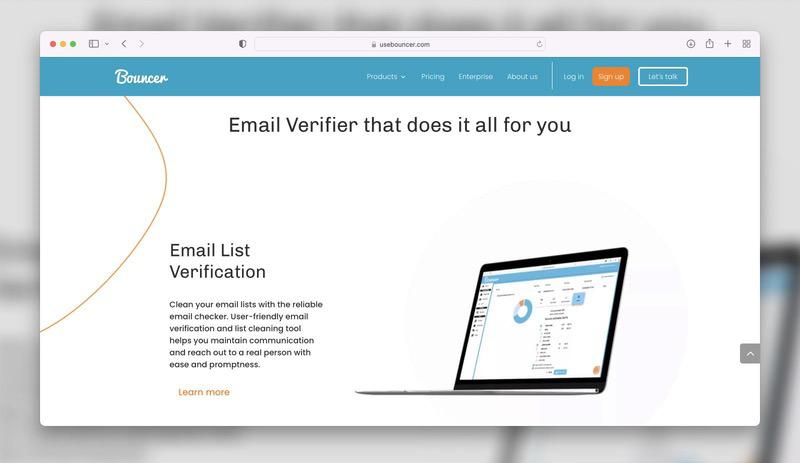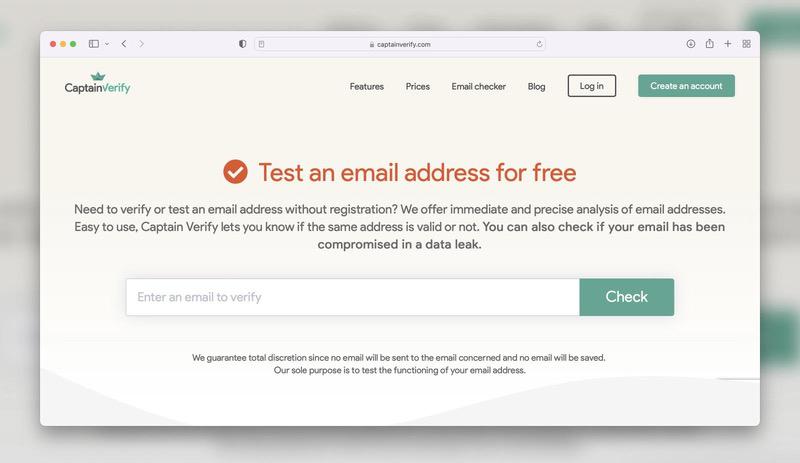What Is Email Verification and How Does It Work?
What does email verification mean? At its core, it’s the process that separates real, active email addresses from invalid ones, ensuring every message you send hits a legitimate inbox.
What Is Email Verification and Its Importance
Email verification helps ensure that the email addresses on your contact list are both valid and active. But it’s not just about cleaning up your email list — it’s about boosting deliverability, protecting your reputation, and maximizing the impact of your communication.
In fact, the average bounce rate across all industries in 2024 is 0.41%, with industry-specific rates ranging from 0.16% to 1.39%. To ensure your email marketing metrics fall within these figures (and focus on high deliverability), you'll need to pay more attention to verification.
Now, before we jump into the details, let's clear up a common misunderstanding. While email verification and email validation are often used interchangeably, they serve distinct purposes:
- Email validation ensures that an address follows the correct format (e.g., user@domain.com) and uses a legitimate domain. Think of it as checking that the address looks right on the surface.
- Email verification, however, digs deeper. It confirms that the address not only exists but can also actively receive messages. This might involve processes like pinging the email server to check its existence.
While validation of email checks for the correct format, verification ensures the email address is operational.
Why does this matter? Because sending messages to invalid or inactive addresses hurts your reputation, reduces deliverability rates, and wastes resources. Email verification saves you from these pitfalls, ensuring your messages are delivered to real users more likely to engage.
How Does Email Verification Work?
The process of email verification might sound complex, but it follows a few straightforward steps that work together to filter out faulty addresses. Here's how to verify an email address:
1. Syntax Check
The first step is verifying if the address is structured correctly. Something like "user@@domain.com" or "userdomain.com" fails this basic syntax test. It ensures that addresses comply with the standard format before moving further.
2. Domain Check
Next, the system checks whether the domain (the part after the “@”) is valid and active. This process confirms that the domain exists and can accept messages – for instance, "gmail.com" is valid, while something random like "emailnowhere.com" may not be.
3. SMTP Verification
Finally, the SMTP verification involves directly communicating with the email server to confirm whether the address exists and is active. Unlike domain checks, this confirms a legitimate inbox on the domain that is ready to receive messages.
These steps combine to eliminate invalid, fake, or improperly formatted addresses, leaving you with a cleaner, more reliable contact list.
Benefits of Email Verification
Investing time and effort into email verification pays off in more ways than one. Here are some of the top benefits:
- Improved Deliverability
Verified addresses ensure your communication reaches valid recipients, reducing bounce rates and increasing delivery success.
- Enhanced Sender Reputation
Internet Service Providers (ISPs) monitor bounce rates. High bounces can signal spammy practices, negatively affecting your sender reputation. Verification prevents this by keeping your list clear of bad addresses.
- Cost Savings
Many email marketing platforms charge based on the size of your contact list. Why pay for sending emails to inactive or fake addresses? Verification ensures you’re only paying for engaged users.
- Better Engagement
When your messages land in real inboxes, you’re more likely to reach engaged recipients who open, read, or act on your messages.
- Reduced Risk of Being Blacklisted
Sending communication to invalid addresses repeatedly can get you flagged as a spammer. Verification lowers your email risk score and protects your domain from being blacklisted.
Choosing an Email Verification Service
With multiple verification tools on the market, selecting the right one can feel daunting. Here are the key features you should look for in a service:
- Accuracy: Check if the tool identifies inactive or invalid addresses while preserving valid ones.
- Speed: For larger lists, speed matters. Choose a service that’s capable of processing lists quickly.
- Data Security: Data — especially for electronic mail — is sensitive, so the service must have strong security protocols to protect your information.
- Integration: Some tools easily integrate with popular marketing platforms, making the process more seamless.
A Few Email Verification Services You Can Consider
Here are a few well-known options in the market today:
1. VerifiedEmail
VerifiedEmail is a cutting-edge email verification tool that optimizes your email campaigns by ensuring only active, valid addresses remain in your lists. It helps improve deliverability and protects your sender reputation by eliminating risky or outdated contacts.

Key features include:
- Advanced multi-layer verification that checks syntax, domain integrity, and mailbox status
- Real-time processing for instant, actionable results
- Seamless integration via an intuitive web dashboard, REST API, and an embeddable widget for email verification with built-in bot protection
- Detailed reporting and insights to monitor list quality and performance
VerifiedEmail offers flexible pricing options, including a pay-as-you-go plan: Verify Once for 1,000 emails at $7 (≈ $0.007 per email) and an optional Re-Verify Daily subscription at $7.2 per month when billed annually. A free trial is also available.
2. ZeroBounce
ZeroBounce offers a comprehensive email validation system to help organizations remove invalid addresses, identify spam domains, and improve deliverability.

Key features include:
- Detection and removal of email abuse and spam traps
- Identification of toxic domains and temporary accounts
- Appending missing email data such as name, gender, and location
- Detailed reports and data insights
ZeroBounce provides flexible pricing options: Pay-As-You-Go that starts at $20 for 2,000 validations or monthly subscriptions depending on the number of addresses to be verified. Free trial is also available with 100 free monthly validations.
3. NeverBounce
NeverBounce offers both real-time and bulk email verification services.

Its key features include:
- Real-time email verification API for instant results
- Bulk email list cleaning
- Real-time verification
- Automated contact list cleaning
Pricing and subscription are flexible — you can go on a pay-as-you-go, monthly, or yearly basis. There’s also a free trial that analyzes your list for no extra cost.
4. Bouncer
Bouncer helps you clean your contact list by removing invalid, inactive, or non-existent electronic mail addresses.

Its key features include:
- Disposable checker
- Customizable download options
- Domain and syntax validation
- Role email detection
You can subscribe as pay-as-you-go basis and its minimum plan offers 1,000 credits for $5.
5. Verifalia
Verifalia is another verification platform offering both single and bulk email validation services.

Its key features include:
- Developers API
- Free and open SDKs
- 6,000+ integrations
- Embeddable widget
- 50 classification overrides
The pricing plan varies depending on the number of addresses to be verified — you can choose from monthly, quarterly, or yearly subscription plans, starting at $7.90 for 1,000 validations.
6. Captain Verify
Captain Verify offers real-time verification, anti-greylisting technology, and an easy-to-use interface. It provides email list cleaning that shows valid/invalid addresses, risky ones, unknown, free, disposable, protected, and duplicates.

You can choose from different plans based on the number of validations required — starting at $7 for 1,000 validations per plan.
Wrapping It Up
Email verification is not just a housekeeping task; it’s a strategic move that ensures the efficiency and effectiveness of your marketing campaigns. By removing invalid and inactive addresses, you’re not only protecting your reputation and improving deliverability but also maximizing the impact of your investments.
Whether you manage a small contact list or handle massive campaigns, prioritizing verification is the smart move to maintain a healthy, responsive subscriber base. Don’t leave your marketing performance to chance — verify email, connect, and engage with confidence.
Verify 200 emails for free. For lists over one-million emails, we will beat the price of any competitor, guaranteed.

